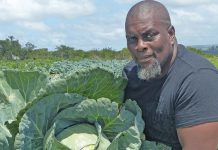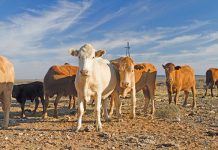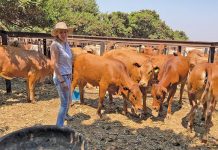
Photo: Lindi Botha
When asked what his biggest farming challenge is, Sizo Tshabalala, stud manager at Gubuda Bonsmaras in eManzana, Mpumalanga, laughs, shakes his head and says: “I don’t have difficult days; I love farming. Every challenge is simply an exciting opportunity to solve a puzzle.”
It is this infectious enthusiasm that has seen Tshabalala rise from every setback he has experienced to become the successful farmer he is today. And it is his approach to problem-solving in particular that landed him a job running the Gubuda Stud for Dr Absalom Nkosi, a part-time farmer from Cape Town.
“Dr Nkosi has been a family friend for many years. He wanted to employ someone he knew, and someone whose passion for farming was evident. You shouldn’t employ a herder who herds cattle by throwing rocks at them or hitting them with a stick.
“A farmer or farm manager must want to farm, and must care about the animals. There are so many challenges in farming; if you don’t love the whole lifestyle, you shouldn’t be a farmer, because the challenges will get you down. You must be fully invested, and I can honestly say that I am,” explains Tshabalala.
Steep learning curves
Tshabalala always knew he wanted to be involved in farming in some way or another. So when he matriculated, he looked at the agricultural degrees available and settled on animal production.
After graduating in 2010, he did an internship at the Department of Agriculture, Land Reform and Rural Development, travelling with extension officers to visit farmers and advise them on best practices.
“I loved this part of the job – going out into the countryside, breathing in the fresh air and walking among the animals. The farmers were all so happy doing what they were doing, but I’d have to go back to the office and sit behind a desk.

“I became increasingly aware of how the people in the office would complain about their jobs and the money they made, while the farmers were out there tackling their challenges with gusto, not complaining about the work.”
When his internship came to an end and no permanent job was forthcoming, Tshabalala decided to stay on in the position as a volunteer, with the hope of being employed eventually.
This turned out to be a big learning opportunity, as he quickly realised he would have to work even harder to be able to impress his peers enough to be taken seriously as an employee.
“I knew I needed to absorb all the information I possibly could and use every opportunity to make the most of this time, because I wasn’t getting paid. But eventually I realised that although I was learning a lot, what I really wanted was to be out in the field, so I took the plunge, bought a piece of land and started farming.”
However, it turned out to be an even tougher lesson for Tshabalala, and he admits that he failed at just about everything he tried.
“At one stage I had a small herd of Boer goats, of which 43 were pregnant ewes. But 39 aborted, resulting in 76 kids that died from chlamydia. It was devastating! So I sold the herd and tried vegetable production instead, but was wiped out by the drought.
“I kept failing, but I learnt something from every failure, and despite the hardships, I still enjoyed farming and kept at it.”
Tshabalala’s first success came when he started producing eggs in 2020, from where he worked his way up to the 13 500 eggs he now produces daily.
In 2021, he took up the position of manager of the Gubuda herd. What started as a commercial herd of mixed-breed cattle now includes a Bonsmara stud to add favourable traits to the commercial animals, and provide neighbouring farmers with good breeding bulls.
Selection and breeding
The stud consists of 450 cattle, of which eight are bulls and 250 are breeding cows. If any specific traits are not already present in the herd but need to be added to it, semen is bought in and cows are artificially inseminated.
Traits that Tshabalala specifically looks for include smaller calves that develop into heavy weaners, good muscling, good milk production, a shorter inter-calving period (ICP), and sturdy cattle with good top lines. He notes that smaller calves are especially important in order to guard against birthing complications. The stud’s average birthweight is about 28kg.
The breeding season starts in January with a selection process to determine which animals will be mated and which genetics need to be brought into the herd. Special care is taken to avoid mating related animals.
Cows are synchronised to come on heat simultaneously, and are artificially inseminated in February. Cows that come on heat later, and those that fail to conceive in the first round, are inseminated again in April.
All female animals are placed with follow-up bulls in camps after they have been inseminated.
The ICP is between 360 and 380 days, and this is an aspect that Tshabalala is trying to improve. Any female animal that skips a breeding cycle is culled.
Grazing and supplements
Calving season takes place between October and December, at which time the veld is in top condition and ample grazing is available.
“Cattle are supposed to eat grass, not your pocket,” says Tshabalala. “Calves must get used to the veld conditions as soon as possible so that they maintain condition through grazing, not bought-in feed.
“In-calf cows are given supplements, but otherwise they live solely on the veld. It’s therefore also important for the calves to be weaned by May, as lactating cows can’t survive on the winter veld alone, and it’s very expensive to feed them.”
The current stocking rate is 6ha/MLU, but the plan is to reduce this to ensure better veld usage. “Our camps are too big, so the cattle graze selectively, which isn’t good for the veld in the long run. We’re in the process of reducing the camp size so that we can rotate the cattle faster and allow them to graze all of the grass in a camp.”
Calves are weaned when they are between nine and 12 months old, and a weaning rate of 95% is achieved. As the calves are susceptible to disease during weaning, they are given an immune booster to keep them in good health.
Keeping stress at bay is also important, and Tshabalala ensures that weaners have ample access to feed and clean water, and moves them as little as possible.
Keeping the calves out of sight of their dams helps them to adapt faster. “The weaners get stressed if they see their mothers in the camp next door, but can’t get to them. If they do, they start to ram up against the fences, injuring themselves and damaging fences.”
He notes that the Bonsmara is highly adaptable, which was one reason why this breed was chosen for the farm.
“There’s a lot of heartwater in our area, but we find that the Bonsmara copes well. When we started the herd, they adapted quickly and have passed on their resistance to heartwater to the next generation. The animals that did contract heartwater obviously couldn’t be used for further breeding, so their weaker genes weren’t included in the herd.”
Performance testing
The cattle are put through Phase D performance testing before being used for breeding.
“These tests ultimately determine whether our cattle will perform in the feedlot, which is the whole purpose of cattle production,” explains Tshabalala.
“During the tests, feed conversion rates are determined, and the cattle are inspected by the breed society and given body condition scores. The maximum score is nine, and animals with seven or more are either kept or sold, while those with scores below seven are culled to ensure that only the best animals are used for breeding. This is important to maintain the high standard of the breed.”
Another reason for testing, he adds, is to give their stud credibility amongst potential clients.
“Farmers who purchase our breeding animals must be assured that the animals will add value to their commercial herds and produce the [highest] volume of beef.
“Because we know what’s in our herd, we know what our potential is, and where we need to improve to achieve better stud animals.
“It also helps our bottom line, because it’s inefficient to keep underperforming animals that require more resources to produce the same amount of beef as those that eat less.”
The breed society also inspects female animals. If they don’t make the grade for the stud, they are placed in the commercial herd and grown out for beef.
Gubuda Bonsmaras regularly hosts farmers’ days, where local producers can learn more about cattle production. These days take place when the cattle have their final Phase D inspection, so that the farmers can see first-hand what good bulls should look like.
Tshabalala says farmers’ days hold great value, as it is far better to see inspections as they happen than to read about how cattle should be farmed.
The quest for balance
Running a successful cattle stud requires a keen eye for balancing genetic traits to obtain the ideal bull. For Tshabalala, this means being careful not to overcorrect a trait or get caught up in fads that result in unnatural-looking animals.
“When you look at breeding values, certain traits have higher values than others. Chasing after a higher value in one particular area means you are taking away from other areas, which could be detrimental if the values don’t balance out.
“For example, double muscling in bulls seemed to be ‘in fashion’ a few years ago. These bulls were ‘it’, and they would grace the covers of magazines. But when we bred these bulls, we found that their calves were too big and the dams struggled during birth, so now I look for balance.”
He stresses the importance of looking at a bull’s entire history, rather than judging it solely on appearance.
“I’ve seen the most beautiful bulls produce ugly calves; it’s an expensive mistake to make. Stud breeding is a marathon, not a sprint. It takes a long time to build a good herd, and mistakes in selection cost extra time.
“Stud breeding can also be compared with making a pan in which to bake a cake. We shape and mould the pan, and the commercial producer buys the pan so that they can make a product that takes on the shape of that pan.
“The ultimate test for you as a stud breeder is whether the commercial farmers who buy your bulls achieve success in breeding them, producing progeny that look like the stud.”
Tshabalala says that solving challenges and finding the best way forward are part and parcel of farming, and he finds them invigorating.
“If you wake up every morning with a problem-solving mentality, then farming will become an exciting challenge and a joy,” he adds.
Email Sizo Tshabalala [email protected].













